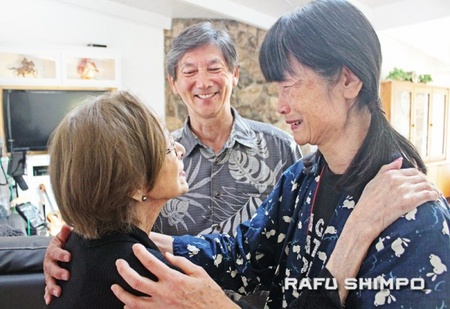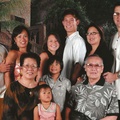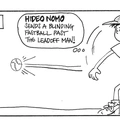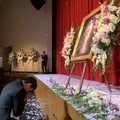Joy and sorrow as a son reunites with his biological mother after more than six decades.
To my family both new and old …
Last summer, Terry Weber sat down at the computer in his North Torrance home to write a letter to the family of Kimiko, his birth mother, who gave him up for adoption in Japan when he was two months old.
He writes:
“Now that I know the circumstances of my being adopted, I have no bad feelings for my mother, Kimiko. I only wonder if she is okay.
I would also like her to know that I am okay and I have a beautiful family. I would like to thank her for giving me life! If she doesn’t want to meet me or know me, that’s okay too.”
Terry reunited last spring with cousin Naoko Shimamura, with the help of the Japanese television program “NHK Family History.” Naoko’s tenacious decades-long quest to locate her lost cousin had returned Terry to his Japanese family.
He is Terry Eugene Weber, the adopted son of Joe and Esther Weber, and he is also Tetsu Shimamura, born in Tokyo, the son of Yojiro and Kimiko Shimamura. He was loved by his Japanese parents, but tragic circumstances led to his adoption. Yojiro, an artist and poet, died of tuberculosis at age 37 — what had become of his birth mother Kimiko remained a mystery.
Naoko and NHK helped to answer one lingering, uncomfortable question: why would Terry’s mother leave him at an orphanage? Through their research he came to understand the difficulties his mother, just 20 years old, had faced. Kimiko’s decision was made to protect her young son from the deadly disease that had claimed his father. Joe and Esther Weber offered the hope for a better life in America for little Tetsu.
“She must have gone through so much turmoil with my father being sick, having a newborn son and wanting to protect me from the dreaded TB,” Terry says with newfound appreciation.
More than 60 years later, Kimiko was closer than ever, but she was an enigma, a core part of Terry’s identity that remained hidden.
“What has happened to me the past few months has been life-changing. If I am so lucky to meet Kimiko and her family I would feel like fate has brought us full circle,” Terry says.
Find Your Japanese American Roots
With his wife Sharon’s encouragement, Terry attends a class on genealogy at the Japanese American National Museum last July titled “How to Find Your Japanese Immigrant Ancestors.”
Led by Marisa Louie Lee, the JANM class focused on how genealogists can find records relating to their family in federal government records, including passenger manifests and immigration case files maintained by the National Archives and Records Administration.
“I discussed techniques for using www.ancestry.com — and how to understand and contextualize records found on that website,” Lee explained.
Terry and Sharon, inspired by meeting with cousin Naoko, start their online search for his birth mother. From his Japanese birth certificate, Terry knew her maiden name, Tazawa, and her date of birth.
During her research in Japan, Naoko discovered that Terry’s mother Kimiko had married an American and moved to the United States in the 1950s. Zushi High School, where Kimiko attended, maintains updated alumni records and yielded a clue to Kimiko’s married name. An employee of the school tells Naoko a name: 君子・ローシュ. Because of the phonetic nature of katakana, the exact English spelling of Kimiko’s married name is unclear.
With these tantalizing bits of information, Terry begins searching immigration lists and passenger manifests for his birth mother.
“I put in ‘Kimiko,’ and kept looking up a bunch of names and passenger manifests from 1952 to 1955, but the birthday didn’t match.”
“I started to give up,” Terry said.
After hours of searching, Terry wearily goes to bed at 2 a.m. His wife Sharon continues the search the next morning.
On a passenger manifest Terry had discovered from Pan Am Airlines on May 24, 1955 there is listed a “Roche Kimiko T.” Could the “T” stand for Tazawa? Sharon does a search on Google.
Excitedly, Sharon wakes Terry up.
“Terry, I found your mother,” she says.
Kimiko Roche
Terry’s mother: Kimiko Tazawa Roche.
“When we put in ‘Kimiko Tazawa Roche,’ her addresses and her kids’ names all popped up,” Terry said.
After Yojiro’s passing, Kimiko eventually married Alvin Roche, an American who ran a furrier business and then a pearl exporting business in Japan. Together, they have two children: Alan and Alana, who spend their formative years in Japan. In 1955, he brings his family to Honolulu, Hawaii for short time before returning to Japan. They finally return to Hawaii where Kimiko and Alvin retired. These passenger manifests are the documents that lead Terry to his birth mother.
But how do you approach the woman who gave you up for adoption six decades ago? A computer search yielded the answers that Terry had sought, but what to do with that information?
One aspect of genealogy goes straight to the nature of family and the secrets we keep: revealing long-kept secrets can be upsetting and life-altering. There was the possibility that Kimiko did not want to be found by her long-lost son.
Terry was initially skeptical and hesitant when NHK first approached him with the surprising news that he had a cousin searching for him in Japan. He had to assume his birth mother and her children would feel the same.
To his amazement, he finds out that Kimiko, now 87 years old, lives in Glendale, less than 30 miles from Torrance. It turns out that his father Joe and mother Kaneko (Joe remarried after Esther passed away) had known Kimiko resided in Los Angeles when Joe asked Terry years earlier whether he wanted to find his birth mother. The federal government had found Kimiko during the course of conducting a background search as part of Terry’s security clearance for his job at TRW.
“My dad asked me during that time frame, ‘Do you want help to find your birth mother?’ I told him definitively, ‘No, you are my parents and you have given me so much.’ And we left it at that.”
Since the beginning, Terry’s quest to find his family has been marked by coincidences and happenstance. Remarkably, Alan Roche, Kimiko’s son, has a home in Pacific Grove, just two blocks from Terry’s younger sister Melba (Mel).
Mel speaks to the architect who is working on the home. The architect agrees to give Mel’s contact information to Alan’s wife Debra. After many text messages and Mel sharing documents and pictures with Debra they eventually talk. Debra will be the intermediary, conveying the shocking news to Alan, Alana, and eventually Kimiko.
In his letter to Alan, Alana, and Kimiko, Terry pours the feelings of love and appreciation that have grown over six decades; the hopes and dreams for the family he has only recently found out about.
“Joy, tears, jubilation, wondering, fear of the unknown, a rollercoaster of emotions these past months,” he writes.
He sends the letter, unsure of how it will be received.
Mother and Child Reunion
Tetsu and Kimiko together at last.
Fate — unmei — and dogged research reunite them for the first time in September 2017.
Kimiko’s son Alan says he was shocked when he received Terry’s letter. Both Alan and Alana, were educated in Japan and are fully bilingual. He spoke in Japanese to express his feelings. .
“I never imagined that I have a brother,” Alan says.
When he first received Terry’s letter, he thought that it was some kind of itazura (mischief).
“But Terry sent us his birth certificate and a photo of my mother. Furthermore, his letter was consistent and all the information, including names and dates were correct,” Alan observes.
“I instantly understood — これってうちのおふくろだよね! Korette uchi no o-fukuro da yo ne. (Wow, this is my mom!)”
In September, Terry arranges a family reunion. At Terry’s home, Kimiko embraces the son she lost so many years ago. There are tears in her eyes. She is frail and delicate. Her children Alana and Alan are there, as well as Alan’s wife Debra and Terry’s wife Sharon.
The families coordinate a larger reunion in October, to give everyone the opportunity meet one another. Kaneko Weber travels from her home in Seaside in Monterey County for the occasion. She smiles, knowing that this is what Joe Weber had wanted for his son so many years ago.

Naoko Shimamura travels from Kashiwa, Chiba-ken to meet Kimiko; she gives Kimiko a portrait that Yojiro painted of her as a schoolgirl. She also gives her a book of Yojiro’s paintings and poetry that she has gathered through her decades of research.
Sharon’s mother Sally Nishinaka and her brother Jeff are also present to meet their new relatives.
Brothers Terry and Alan marvel at the twists of fate. Both men enjoy golfing and they figure they have probably crossed paths throughout the years without knowing it. Alan is a managing director of Mizuho Financial Group, and often frequents the local Japanese markets and restaurants in Torrance.
Kimiko, although weak, is clearly delighted to meet her new grandchildren and great-grandchild.
Mark Weber says with joy, “I have three grandmothers now!” He introduces Kimiko to his wife Linda and 13-month-old daughter Alexis Sayuri. He lovingly recalls, I got to hear grandma Kimiko say “I love you Alexis!” to her great-granddaughter.
Lauren Weber says with amazement: “Without Naoko’s passion, we wouldn’t all be here. It taught me an important lesson: Don’t hold back. Do the things you are passionate about.”

Kimiko’s happiest moments are shared with her son. In the smallest of gestures and glances, her love for her Tetsu is clear.
“Terry, my boy. Honto, honto ureshii (I’m really, really happy), Don’t go anywhere,” Kimiko says to him, wistfully.
Slowly, she reveals the truth of the secret that she kept hidden for so long.
“I’ve never talked about him to others.” Kimiko says, speaking in Japanese. “I gave up on the idea of ever meeting him. But when I first met Terry, I was really happy to know that my boy had become a very nice man. Alan also said that he is happy to have a brother!”
In her own words, Kimiko reveals the difficulties she faced as a young mother and later as a widow living in California.
“I was innocent at that time. After the war, I lost my father. I think my mother experienced a very tough time… My husband Alvin Roche passed away and there are no relatives here, so I thought that my family is only my son, daughter and grandchildren.
“But surprisingly, Tetsu showed up in front of me. I have big family now and I feel so happy.”
Lost Time
Over the next months, Terry and Kimiko slowly build their relationship, making up for the years lost. They get together over lunches and dinners. He learns of the scoliosis, a curvature of the spine, that makes it painful for Kimiko to stand or sit for prolonged lengths of time.
He learns more about his birth father Yojiro. Kimiko recalls Yojiro as an artist who would leave the house with a paintbox in hand and return late at night.
He finds out of the loving care his siblings Alan and Alana give to their mother Kimiko. Every weekend, Alan takes Kimiko to his home in Indio. On weekdays as Alan travels for work, Alana drives from her home in Valencia to be with her mother in Glendale.
Gradually, the siblings form the rhythms of a family, calling and texting one another often. At Christmas time, Kimiko tells her daughter that she wants to give Terry a present.
In a shaky hand, she grasps a shodo brush. Over 30 attempts, she guides the brush. Alana has to buy more ink so Kimiko can write her calligraphy until she is fully satisfied.
Terry receives the gift from his mother. It is the strong name from so long ago that has brought them back together.
In elegant black ink, she writes simply: Tetsu.
A Sudden Farewell
“The stars aligned,” Terry says, his voice quiet and heavy with sadness.
Life has a way of coming full circle. From birth to the fullness of youth, to adulthood and its responsibilities, and at last, to old age and death.
Kimiko Tazawa Shimamura Roche passed away on Feb. 25, 2018.
Her death was sudden and unexpected. Years of pain are finally too much for her frail body. The family planned a small, private service. Alana tells Terry that in the ICU, Kimiko is revived and she says she was so happy that she could be here so she could meet Terry.
Having been inspired by his mom’s precious calligraphy and encouraged by Naoko to draw, Terry decides to draw two portraits. Using his father’s passion for oil pastels, Cray-pas, he draws his self-portrait and also a portrait of a younger Kimiko with plans to frame them as a pair and give to his mom.

Sadly, the portraits still sit unframed.
For Terry, there is grief and also gratitude. In those precious too-few months together, he could say what he couldn’t say for more than 60 years. He could call Kimiko “Mom.”
“I got to thank her for giving me life, for the hardships she endured, for sacrificing so much love and pain and the anguish she must have felt in making the decision to give me up for adoption,” he says.
Kimiko left Terry but she has not left him alone; he now has new siblings and a new family.
A strange journey that began at the Chester Washington Golf Course has expanded Terry’s life and redefined the simple things: family, hope, sacrifice, strength and most importantly, love.
“To hear her precious stories and to hear her say ‘I love you’ and to be able to tell her ‘I love you’ meant so much,” he says.
He also recalls longingly, “Our hugs were long and sweet they said many things to me in mom’s quiet way! Her hugs told me, I missed holding you, I’m sorry for giving you up, I love you and you make me so happy! Thanks mom for the hugs!”
“What I take most from her passing is saying ‘Thank you’ and ‘I love you’ to the people that care about you. Hug them, hold them dear because it is never enough! More is better than less and sooner is better than not at all! Life is too short to squander those moments.”
* This article was originally published on The Rafu Shimpo on March 15, 2018.
Japanese version of this story can be read here >>
© 2018 Gwen Muranaka / The Rafu Shimpo








